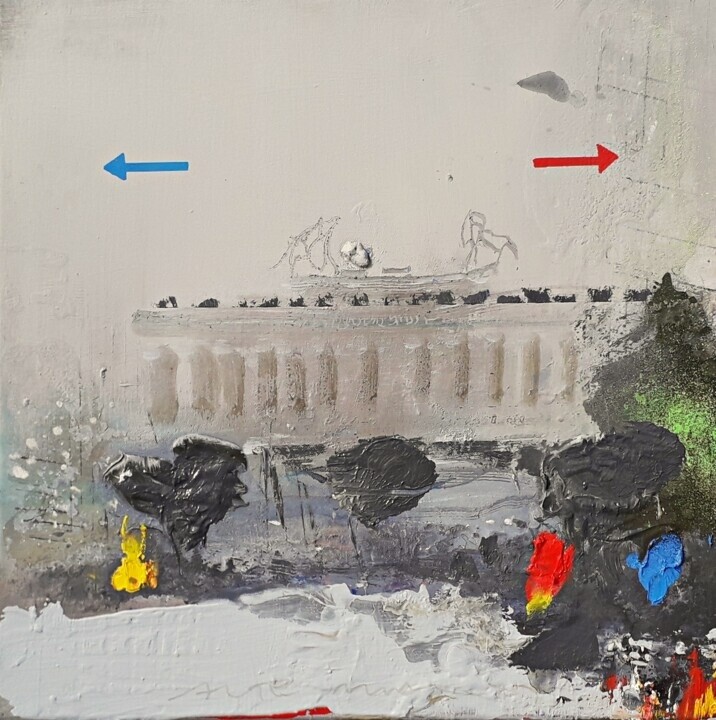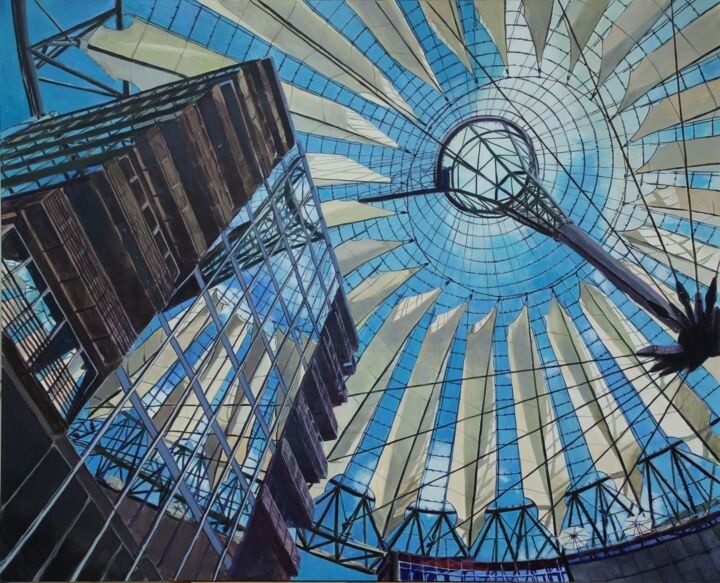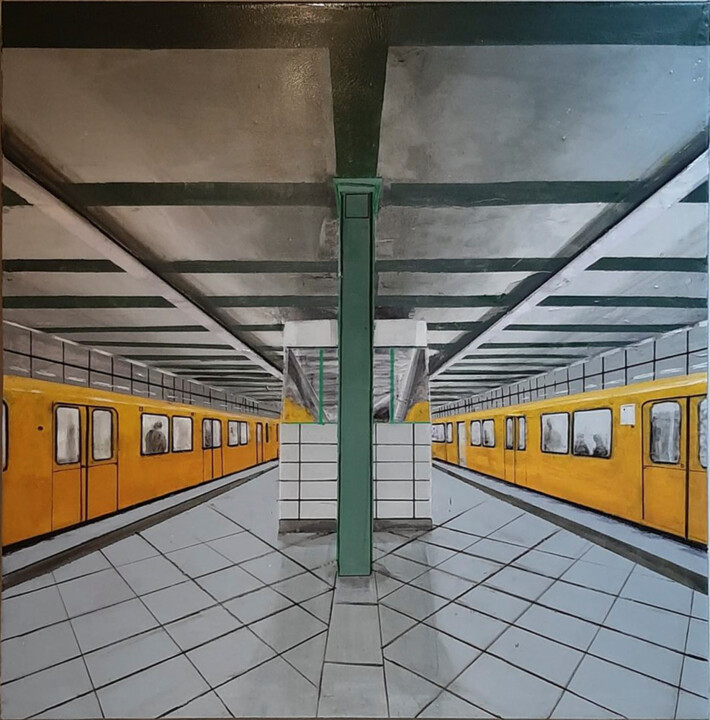 BERLIN STORY (2021)Painting by Ilgvars Zalans.
BERLIN STORY (2021)Painting by Ilgvars Zalans.
Art above and below the surface
When we speak of cityscape, a pictorial genre that arose in the 18th century to immortalize mainly city landscapes, sometimes even taking them exclusively from life, we immediately think, as a kind of uncodified reflex, of Canaletto's Venice, Gustave Caillebotte's Paris, L. S. Lowry and Kirchner's Berlin, urban realities depicted, dutifully for historical reasons, mainly on the surface, since, at the time of most of the artists in question, subways were not yet fully operational or even ideally conceived. However, these masters did not neglect to give space, within the subjects they investigated, to the most fashionable means of transportation of their period, one thinks, for example, of Monet's La Gare Saint-Lazare series (1877) or The Railway Platform by the aforementioned L. S. Lowry, works that were part of a very broad reality, including masterpieces with regard to the popular railway theme. Now, that we are in 2023, we might suggest that painters enter the subways more often, in order to immortalize them, continuing the narrative started by the most celebrated exponents of art history. So, to satisfy my reflection, come some of the artists of Artmajeur, who have depicted Berlin, making exclusive reference to its U-Bahn, a means of public transportation that is not only functional for travel, but also of relevant historical value, which deserves to be introduced and, subsequently, deepened through the medium of painting.
 BERLIN POTSDAMER PLATZ (2014)Painting by Emilia Amaro.
BERLIN POTSDAMER PLATZ (2014)Painting by Emilia Amaro.
The Berlin subway
The aforementioned subway began to be built as far back as 1896, only to be completed, in its first section, aimed at joining Potsdamer Platz with Stralauer Thor, in 1902, the year in which further extensions were undertaken, which lasted until 1910. The extension of the U-Bahn continued after World War I, so that by 1930 the network reached 76 kilometers in length, which remained more or less so during the following year, due to a prevailing and new economic crisis in the country. The subway did not undergo major changes even during the National Socialist period, although plans were made for the implementation of a massive expansion. The story in question became even more interesting during the outbreak of World War II, a time when the capital's vigorously bombed U-Bahn suffered considerable damage, succeeded by swift but somewhat difficult repairs that led to the closure of the lines in 1945. Nevertheless, between the end of 1945 and the course of 1950, restoration operations were completed, although other issues arose with the impending division of the city, which, as a result, entailed that of the railroad network, which became distinct into two autonomous trunks, within which many unused stops became veritable ghost stations. Moreover, during the years of the division, many stations in the east, consequential to the toponymic change in communist terms of various streets and squares, changed their names, in addition to the fact that the same network was integrated with the more extensive S-Bahn, while the metro in the west, which was already more extensive, was expanded considerably, both to replace the S-Bahn operated by the eastern authorities and to better serve the new traffic routes. Finally, the happy ending of this separation, as we could well imagine, came subsequent to the tearing down of the wall, a time when the ghost stations began to reopen, as well as the removal of border blocks. It all officially ended on October 3, 1990, which was with German reunification, an event that also brought about the gradual and complete unification of the metropolis. Now we come to the pictorial and silkscreen narrative about the Berlin U-Bahn, which will take shape in the analysis of paintings by Kew, Yuriy Kraft and Ana Del Castillo Ibarrola.
 BERLIN U-BAHN (2021)Printmaking by Kew.
BERLIN U-BAHN (2021)Printmaking by Kew.
Kew: Berlin's U-Bahn
The subterranean vision offered to us by Kew's silkscreen print, part of a series of five works of the same subject, but different colors, may have been sketched from life, pursuing the purpose of giving voice to that fateful moment when weary, harried and highly irritable workers wait for the subway after a hard day's work, apprehensively observing in front of them the swift arrival of the means of transportation, which will finally take them back to their abodes, where they will guard the subway pass, to reuse it repeatedly in the days to come. The artwork could also have been conceived from a photograph, as it is very popular to capture the subway, especially with a cell phone, to give rise to Instagram stories, ready to make others aware of our impending displacement. Social media aside, the screen print explicitly shows the name of the stop in question, namely Hallesches Tor station, which opened in February 1902, along with the first subway line from Stralauer Tor to Potsdamer Platz. After I had a good understanding of the nature of the stop, making wise use of Wikipedia, I was able to satisfy another curiosity of mine by learning about what, a long time ago, could be seen outside the present station: the Hallesches Tor gate, part of the old customs wall, built to replace the city wall in the 18th century, known as the only gate through which, until the Jewish edict of 1812, Jews could pass and register in southern Berlin.
 ***HAUPTBAHNHOF, BERLIN*** (2018)Painting by Yuriy Kraft.
***HAUPTBAHNHOF, BERLIN*** (2018)Painting by Yuriy Kraft.
Yuriy Kraft: Hauptbahnhof, Berin
Kraft's watercolor frames horizontally, assuming a point of view that simulates that of the standing observer, probably intent on walking inside the subway, the sudden meeting between two trains. Such an event, which may occur more or less frequently, could perhaps evoke the semblances of a fleeting kiss between lovers, who, forced to travel on ever-changing routes, would recall the saddest and most impossible reunion between sun and moon. Returning to the place of the station, it is possible to state how sometimes, when we walk alone within it, after having done almost compulsively all our things, by now tired and confused, we can observe the above also somewhat stunned, almost astonished by the overlapping of an arrival, which we were only, and obligatorily, expecting on one side of the tracks. Speaking of the subway in question, the artist, by means of the title of the work, makes clear the place captured, namely Berlin Hauptbahnhof, the city's central station, which, inaugurated in 2006, is located in the center of Berlin, precisely in the Moabit district. To elaborate on this place, however, we have to go back, once again, to those fateful 1990s in which, shortly after reunification, city planners had to address the issue of the reorganization of urban transport, generating that idea later implemented, of giving life to a modern multi-level intersection station, aimed at taking shape, at the surface level, in the features of the intersection of two glass sheds.
 WEBERVIESE STATION BERLIN (2022)Painting by Ana Del Castillo Ibarrola.
WEBERVIESE STATION BERLIN (2022)Painting by Ana Del Castillo Ibarrola.
Ana Del Castillo Ibarrola: Weberviese Station, Berlin
It looks like a skillful reflection of the mirror, but it is not, as the silhouettes of the passengers inside the trains vary, as do the images shown on the column, ready to repeat some of the diversified shapes of the carriages and the gray tracks. The latter color scheme is one of the few used by the painter, who, along with yellow, green and black, wanted to maintain a realist approach, although the "double theme" has a clear aftertaste with a surrealist flavor. In fact, it is actually precisely these dreamlike symmetries and multiplications that make the stop knowable in its essence, which is suddenly revealed through a vision akin to a photographic shot, a medium whose experimentation could also take place on a daily basis, giving us the opportunity to find new angles from which to observe the world, simply by substituting our eyes for those of the cell phone camera. Speaking of the place depicted, it is the Weberwiese metro, a stop on the U5 line, which finds its location under the Karl-Marx-Alle, precisely east of the Straße der Pariser Kommune. The station, which was opened in 1930 under the name Memeler Straße, is known to have been the "scene" of chilling scenes, as, during World War II, precisely in May 1944, it was bombed, a fact that caused the death of 200 people, mostly women and children. Returning instead to the question of the name, in 1950 the station was called Marchlewskistraße, so that to arrive at the appellation in use we have to wait until 1992, the year in which, after reunification, the Berlin Senate decided to name the station in honor of a small park next to it.


 Olimpia Gaia Martinelli
Olimpia Gaia Martinelli























